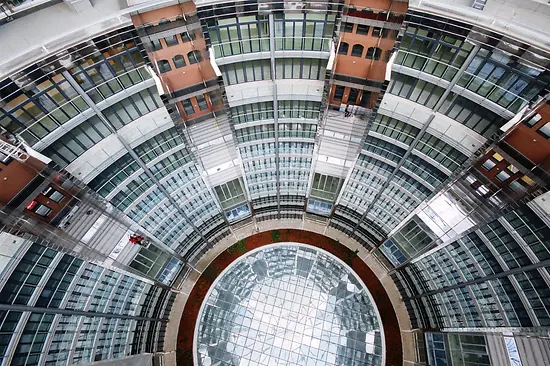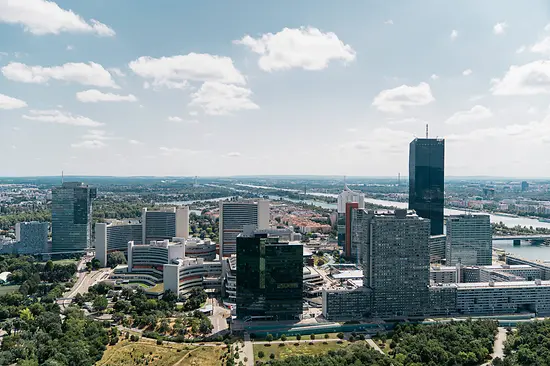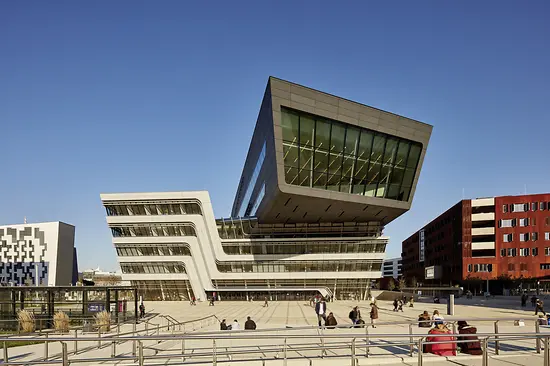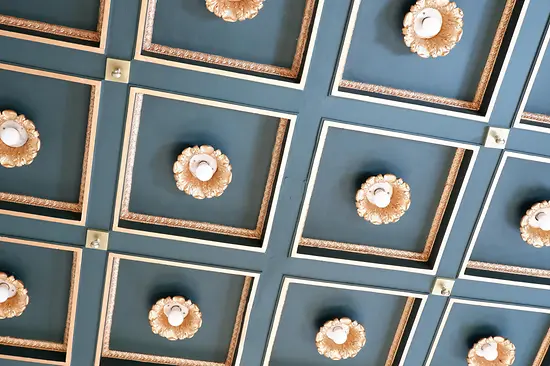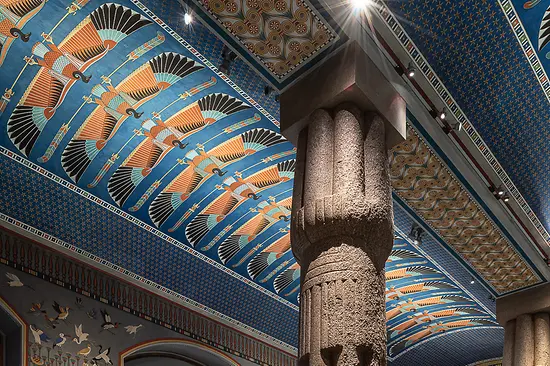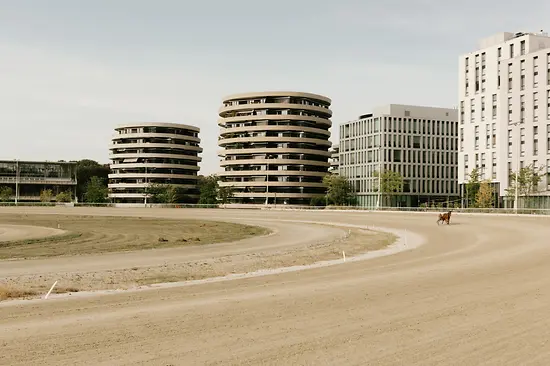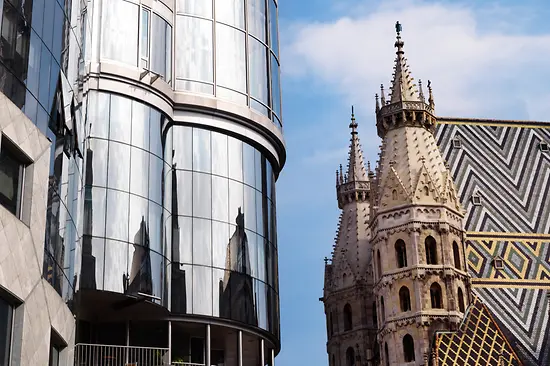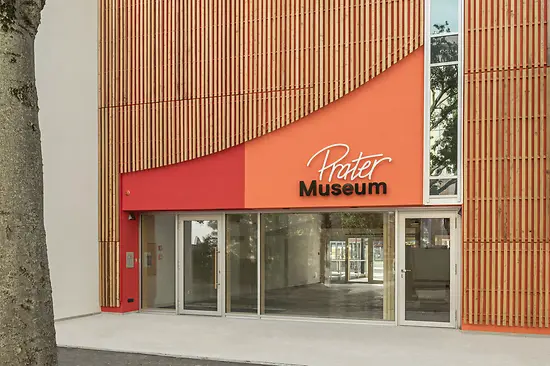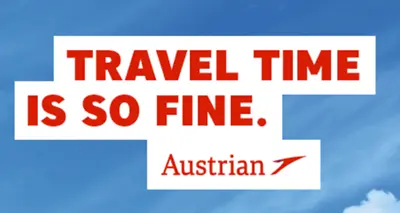Vienna International Center: Border Crossers
Six Y-shaped office towers are arranged in pairs around a cylindrical conference building in a clever configuration that more or less stops the buildings from blocking the sunlight from one another. This ingenious ensemble was created by the Austrian architect Johann Staber, who in 1968 won an international architectural competition to design what would be the United Nation’s third headquarters. Since their completion in 1979, the 127-meter-high towers have been glinting silver in the daylight, with their bold orange accents echoing the fashion of a bygone era. Anyone who enters the Vienna International Centre will not only be taking an architectural journey back in time, but also leaving Austrian territory: like the other three sites in New York, Geneva and Nairobi, the VIC is located on inviolable international territory belonging to the 193 member states.
"The United Nations has its own security service," explains Henri Abued Manzano, one of 20 guides who gives tours of the site. "It's a mini city within a city, with its own fire department, post office, site office, medical services, pharmacy and daycare center." Manzano, who comes from the Philippines, continues: "As a member state, we celebrate United Nations Day every year on October 24. On this day, children put on a wide variety of national costumes and spread the international ethos. It's a beautiful custom that awakened a desire in me at an early age to work at the UN one day."
“The epitome of Vienna’s International Mindset”
Manzano has been a member of the UN visitor team for three years now and feels very much at home in Vienna. As someone who also works as a photographer, he was particularly taken with the historic city’s architecture. “Vienna is like an open-air museum. There’s something to discover around virtually every corner, from the magnificent facades of the old apartment buildings to the courtyards that typically feature in Viennese architecture, such as the Adlerhof in the seventh district." But the city also has a lot to offer in other respects, he adds: "My favorite place to retreat is the French-inspired Augarten. If I have visitors, we’ll head to the Kahlenberg hill – there are magnificent views of the city to be had from up there. And although I'm not a coffee drinker myself, I still really enjoy the cozy Viennese coffeehouse culture. The hustle and bustle of the Brunnenmarkt is a multicultural hotspot." The confluence of so many nations in one place is an integral part of the VIC’s atmosphere: “For me, it is the epitome of Vienna’s international mindset.” During his breaks, Manzano enjoys walking through the interconnected office buildings with their orange stairwells and elevators. "The furniture is still original 1970s," Manzano declares brightly. "I'm always discovering new parts of the complex. For example, I only came up to the eighth floor for the first time now, where the interpreter booths are."
Global Gatherings
Overlooking the wood-paneled conference rooms furnished with cognac-colored leather chairs are heavily soundproofed booths where interpreters can work in peace without being distracted by outside noise. "We usually work in teams of two and swap over every half hour," says simultaneous interpreter Sarah Irene. A US citizen with Italian roots, she has been working at the United Nations for ten years now. "I started out at the UN headquarters in New York and moved to Vienna four years ago with my two horses and two cats." Irene translates Russian and French into English. "In the UN office in Vienna there are no simultaneous interpreters with German as their mother tongue. German is not one of the six official languages – Arabic, Chinese, English, French, Russian and Spanish – nor is it one of the two working languages – English and French. That's one of the reasons why my German is still, unfortunately, pretty poor." Irene rarely has a typical workday. “My workload depends heavily on how urgent the issues at hand are, and how the conferences to tackle them are scheduled, which can sometimes be at short notice."
This means good overall preparation and intense concentration are key at times like this, so it is all the more important for Irene to be able to switch off in her free time. "I live in beautiful Neuwaldegg in the 17th district, where I can clear my head while riding," the interpreter says. “There are so many different sides to Vienna. Beside being extraordinarily picturesque, the city is also full of recreation zones, including the area around the Otto Wagner Villa, which I really like. When I have visitors, for me the Hofburg and the Albertina – including a trip to Café Diglas or Café Landtmann – is a must."
Interpreter and Aerialist
When she’s not riding, Sarah Irene channels her energy into a rather unusual hobby: as an aerialist and contortionist she’s been in numerous shows in Vienna and various other European cities. “Given that I only relay what other people have to say in my job as an interpreter, it's especially important for me to be able to express something of my own in my art." That said, she is happy to know that she is making a contribution to the UN through her work. "Working here highlights how important the UN’s peacekeeping mission is," Irene states. There is much more to it than sitting around a table and just voting on issues. The day-to-day work of UN agencies around the world helps advance and promote cooperation on human rights, security and the global economy, she believes. And where better to realize this commitment than in this historic city? After all, many landmark global political decisions have been made here. It is this special spirit that has helped establish Vienna as a sought-after location for numerous organizations and a magnet for international congresses and conferences.
Text: Rosi Dorudi
UNO-City (Vienna International Centre)
1220 Vienna
-
Vienna City Card
-
Benefits of the Vienna City Card: -13%
Additional information on the offer:
Standard ticket price: 15€
Please book here to get your Vienna City Card discount:
-
-
Opening times
-
Please note: no guided tours on weekends.The Vienna International Centre is closed on UN Holidays and from 21 Dec to 5 Jan.
-
-
Guided tours
-
- For individuals and small groups of up to 10 people, in English, German and further languages: Mon - Fri 11am, 12.30pm, 2pm and 3.30pm, subject to availability. Guided art tour: Wednesdays at 3.30pm. Advance booking recommended. Please consult the latest information about guided tours on the website of the UNO’s Vienna Visitors Service. Official photo ID must be presented.
- Guided group tours in more than a dozen languages can be booked at other times (Mon-Fri).
-
-
Accessibility
-
Main entrance
-
no steps
(Swinging doors 90 cm wide)
ramp at gate 1
-
no steps
(Swinging doors 90 cm wide)
-
Elevator available
-
Further information
- Wheelchair accessible restroom available.
-
Special offers for people with disabilities
Adapted tours for people with disabilities.
-
Comments
Access to all exhibition rooms: no steps.
-
Main entrance







